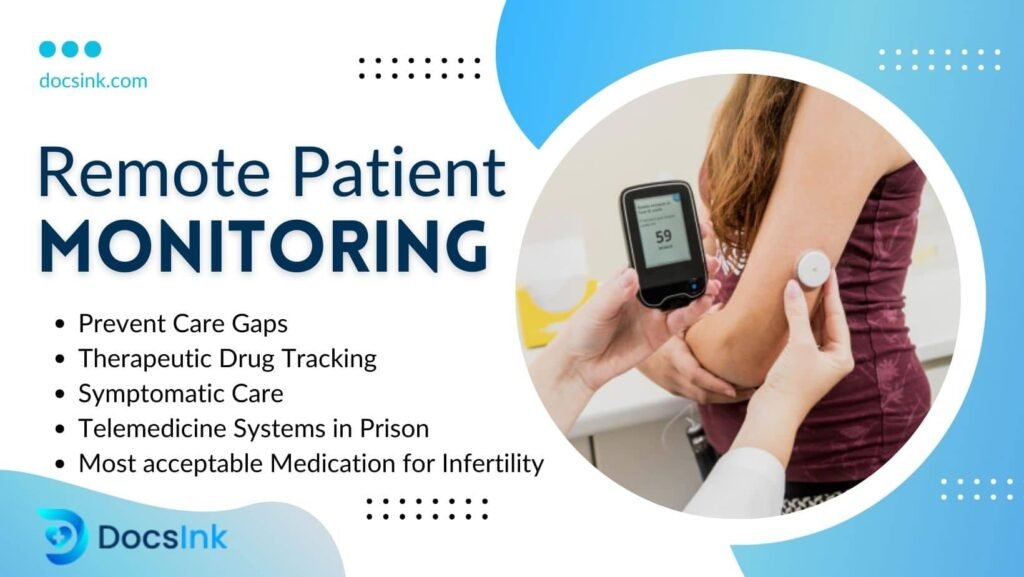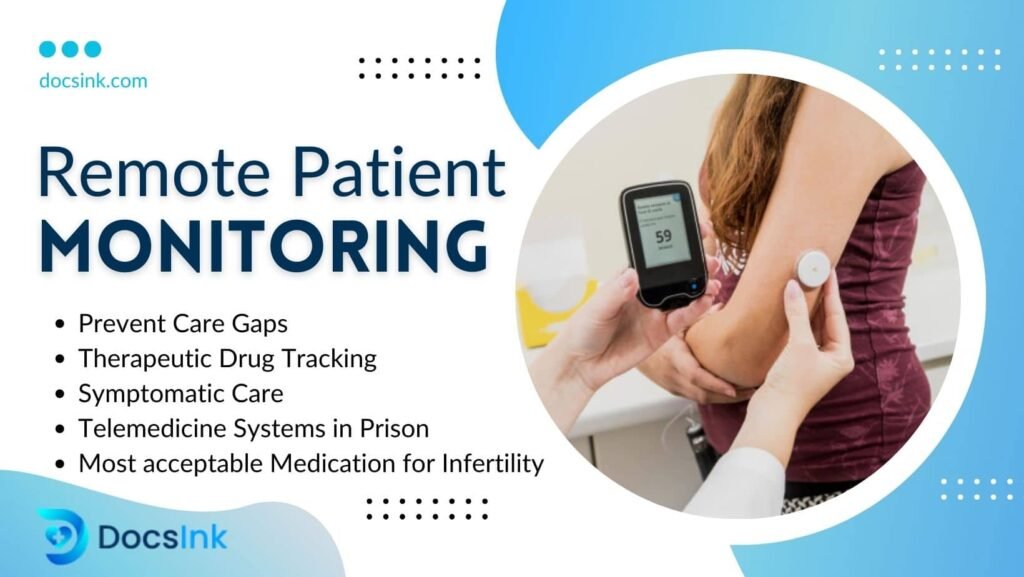
Revolutionizing Healthcare: The Powerhouse Duo of Telemedicine and Remote Patient Monitoring
The landscape of healthcare is undergoing a dramatic transformation. Gone are the days when accessing quality medical care meant battling traffic, enduring long wait times, and facing potential exposure to illness in crowded waiting rooms. Telemedicine and remote patient monitoring (RPM) have emerged as a powerful duo, reshaping the way we deliver and receive healthcare services. This blog delves into the world of these innovative technologies, exploring their potential to improve patient outcomes, enhance healthcare efficiency, and empower individuals to take charge of their health.
Telemedicine: Bridging the Gap in Healthcare Delivery
Telemedicine refers to the use of telecommunication technologies to deliver healthcare services remotely. This encompasses a wide range of services, including:
- Virtual consultations: Patients can connect with healthcare providers via video conferencing platforms for consultations, diagnosis, and treatment discussions.
- Chronic disease management: Telemedicine allows for regular check-ins with specialists, medication management support, and remote monitoring of vital signs.
- Mental health services: Teletherapy sessions provide convenient access to mental health professionals for individuals struggling with anxiety, depression, or other mental health conditions.
- Specialist consultations: Patients in rural areas or with limited mobility can connect with specialists located far away, eliminating the need for travel.
The Advantages of Telemedicine:
The benefits of telemedicine are far-reaching, impacting both patients and healthcare providers:
- Improved access to care: Telemedicine eliminates geographical barriers, ensuring that individuals in remote locations or with transportation difficulties can receive quality healthcare.
- Enhanced convenience: Patients can schedule appointments at their convenience, reducing time spent commuting and waiting in clinics.
- Reduced healthcare costs: Telemedicine consultations can be more cost-effective compared to traditional in-person visits, saving money for both patients and healthcare systems.
- Improved patient engagement: The ease of access offered by telemedicine fosters greater patient engagement in their healthcare journey.
- Reduced risk of infection: Virtual consultations minimize the risk of exposure to contagious illnesses in waiting rooms, particularly beneficial for immunocompromised individuals.
Remote Patient Monitoring: Keeping a Watchful Eye
Remote patient monitoring (RPM) involves the use of technology to collect and transmit a patient’s health data from their home environment to a healthcare provider. This data can include:
- Vital signs: Blood pressure, heart rate, oxygen saturation, weight, and blood sugar levels can be monitored remotely using wearable devices.
- Physiological data: Glucose monitors, pulse oximeters, and smartwatches can transmit real-time data for continuous monitoring.
- Patient-reported outcomes: Patients can use mobile apps to report symptoms, medication adherence, and other health concerns.
The Power of RPM:
RPM offers significant advantages in managing chronic conditions and improving patient outcomes:
- Early detection of complications: Continuous monitoring allows for early identification of potential health problems, enabling timely intervention.
- Improved disease management: Regular monitoring empowers healthcare providers to adjust treatment plans based on real-time data.
- Reduced hospital admissions: Proactive management of chronic conditions through RPM can help prevent complications that might otherwise lead to hospitalization.
- Enhanced patient empowerment: Real-time access to health data allows patients to play a more active role in managing their health.
- Streamlined care coordination: RPM platforms facilitate communication between patients, care providers, and specialists, ensuring coordinated care.
The Synergy of Telemedicine and RPM: A Winning Combination
Telemedicine and RPM work best when used in conjunction. Here’s how they create a powerful healthcare delivery system:
- Data-driven consultations: Data collected through RPM can be used to inform virtual consultations, leading to more focused and effective discussions between patients and providers.
- Proactive interventions: Real-time data allows healthcare providers to identify potential problems early and intervene remotely, preventing complications.
- Improved patient outcomes: The combined power of telemedicine and RPM empowers patients to manage their chronic conditions effectively, leading to better long-term health.
- Reduced healthcare burden: Early detection and intervention through RPM can help manage chronic conditions and reduce the overall healthcare burden.
Challenges and Considerations
While telemedicine and RPM offer immense potential, there are challenges that need to be addressed:
- Access to technology and internet: Not everyone has access to the technology or internet connection required for telemedicine and RPM. Efforts are needed to bridge the digital divide.
- Data privacy and security: Ensuring the security and privacy of patient data collected through RPM is paramount. Robust cybersecurity measures are essential.
- Reimbursement policies: Reimbursement policies for telemedicine and RPM services need to be standardized and streamlined to encourage wider adoption.
- Provider training and adoption: Telemedicine and RPM require training for healthcare providers to effectively utilize these technologies.
The Future of Healthcare: A Brighter, More Connected Landscape
The future of healthcare is undeniably connected. Telemedicine and remote patient monitoring are poised to play a central role in shaping a healthcare landscape that is:
- Patient-centered: The focus will shift towards empowering patients to take charge of their health, with telemedicine and RPM providing the tools and information they need.
- Preventive and proactive: Early detection and intervention will become the norm, with RPM enabling healthcare providers to identify and address potential health issues before they escalate.
- Value-based: The emphasis will be on delivering high-quality care that improves patient outcomes and reduces overall healthcare costs. Telemedicine and RPM offer significant potential in achieving this goal.
- Accessible and equitable: Technology will bridge geographical barriers and socioeconomic disparities, ensuring that everyone has access to quality healthcare services.
The Road Ahead
As we move forward, several key developments will drive the continued growth of telemedicine and RPM:
- Advancements in technology: The development of more sophisticated wearable devices, user-friendly platforms, and powerful data analytics tools will enhance the capabilities and effectiveness of telemedicine and RPM.
- Policy and regulatory changes: Governments and healthcare regulatory bodies will play a crucial role in defining standards, ensuring data privacy, and developing reimbursement models that promote the adoption of telemedicine and RPM.
- Increased patient and provider acceptance: As the benefits of telemedicine and RPM become more widely recognized, both patients and healthcare providers will be more likely to embrace these technologies.
Conclusion: A Call to Action
The potential of telemedicine and remote patient monitoring to revolutionize healthcare delivery is undeniable. By embracing these innovative technologies, we can create a healthcare system that is more accessible, efficient, and patient-centered. Here’s a call to action for various stakeholders:
- Healthcare providers: Invest in training and resources to integrate telemedicine and RPM into your practice.
- Patients: Become informed about these technologies and explore how they can benefit your health journey.
- Policymakers: Develop policies and regulations that encourage the adoption of telemedicine and RPM while safeguarding patient privacy and security.
- Technology developers: Continuously innovate to create user-friendly, secure, and cost-effective telemedicine and RPM solutions.
By working together, we can unlock the full potential of telemedicine and remote patient monitoring, ushering in a new era of healthcare delivery that empowers patients, improves outcomes, and ensures a healthier future for all.
